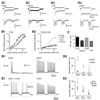A user's guide to channelrhodopsin variants: features, limitations and future developments
- PMID: 20621963
- PMCID: PMC2995811
- DOI: 10.1113/expphysiol.2009.051961
A user's guide to channelrhodopsin variants: features, limitations and future developments
Abstract
Channelrhodopsins (ChRs) are light-activated channels from algae that provide these organisms with fast sensors to visible light for phototaxis. Since its discovery, channelrhodopsin-2 (ChR2) has been used as a research tool to depolarize membranes of excitable cells with light. Subsequent chimeragenesis, mutagenesis and bioinformatic approaches have introduced additional ChR variants, such as channelrhodopsin-2 with H134R mutation (ChR2/H134R), channelrhodopsin-2 with E123T mutation (ChETA), Volvox carteri channelrhodopsin-1 (VChR1), Volvox carteri channelrhodopsin-2 (VChR2), channelrhodopsin-2 with C128 or D156A mutations (ChR2/C128X/D156A), chimera D (ChD), chimera EF (ChEF) and chimera EF with I170V mutation (I170V). Each of these ChR variuants has unique features and limitations, but there are few resources summarizing and comparing these ChRs in a systematic manner. In this review, the seven following key properties of ChRs that have significant influences on their effectiveness as research tools are examined: conductance, selectivity, kinetics, desensitization, light sensitivity, spectral response and membrane trafficking. Using this information, valuable qualities and deficits of each ChR variant are summarized. Optimal uses and potential future improvements of ChRs as optogenetic tools are also discussed.
Figures



References
-
- Bamann C, Kirsch T, Nagel G, Bamberg E. Spectral Characteristics of the Photocycle of Channelrhodopsin-2 and Its Implication for Channel Function. Journal of molecular biology. 2008 - PubMed
-
- Bamann C, Gueta R, Kleinlogel S, Nagel G, Bamberg E. Structural guidance of the photocycle of channelrhodopsin-2 by an interhelical hydrogen bond. Biochemistry. 2010;49:267–278. - PubMed
-
- Berndt A, Yizhar O, Gunaydin LA, Hegemann P, Deisseroth K. Bi-stable neural state switches. Nat Neurosci. 2009;12:229–234. - PubMed
-
- Boyden ES, Zhang F, Bamberg E, Nagel G, Deisseroth K. Millisecond-timescale, genetically targeted optical control of neural activity. Nat Neurosci. 2005;8:1263–1268. - PubMed
Publication types
MeSH terms
Substances
Grants and funding
LinkOut - more resources
Full Text Sources
Other Literature Sources

